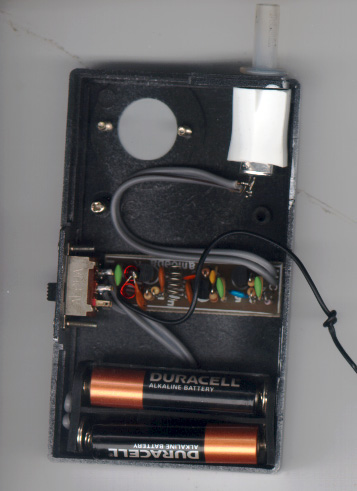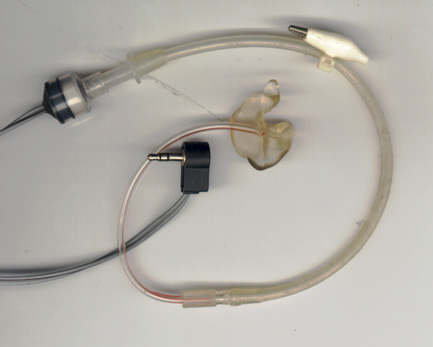FM Transmitters for Oesophageal/Precordial
Stethoscopes

This site is always under construction. Comments and
suggestions would be most welcome. Last update: 27th October,
1999.
I have built two different types of transmitters over the years
for various people. They both come as kits:
1. The "AMOEBA" as sold by Talking Electronics Pty Ltd, 35 Rosewarne
Ave., Cheltenham, Victoria, 3192, Australia. Ph +61 3 95842386. (I
hope this is right, I haven't checked this address for a couple of
years so if you can't get onto them let me know and I'll try to find
out where they are for you.)
Advantages: The book you need to build it (it comes with no
instructions so you have to buy the book) explains how it works in
great detail so it's a good learning exercise; It's tiny, smaller
than a penlite battery; it runs off 3v; you only need to change the
value of one resistor to prevent the high volume of the breath sounds
from saturating the circuit; it's extremely stable (ie frequency
won't drift during a case); costs about AUD$10.00.
Disadvantages: You have to buy the book - AUD$3.95 which I think is
now out of print anyway; They would only mail order a minimum of
AU$30.00 worth (I think) - Buy 3!!!; it has 3 little coils in it
which can be a bit tricky to solder (they are pre-wound so you don't
have to do that bit yourself); the circuit board is very cramped and
this makes construction a bit tricky.
2. The "FM transmitter MkII" as sold by Oatley Electronics, PO Box
89, Oatley NSW, 2223. Ph +61 2 9584 3563. Fax +61 2 9584 3561. E-mail
oatley@world.net and they also
have a web site with a
full catalogue (This address is definitely current).
Advantages: Comes with instructions; is still quite small - about the
size of a 9v transistor radio battery - not so cramped; you only need
to swap two resistors for stethoscope use; its coil is inside a can -
a bit easier to handle and tune; it costs about AU$12.00.
Disadvantages: I can't remember which resistors you need to change
and I don't have a copy of the circuit so you would have to fax it to
me to work it out again.
Please also note, they sell a MkIII version which runs off 6V, has
greater range, and which has less deviation so the saturation may not
be so much of a problem (ie you might not have to change anything). I
have not built this one so I can't say for sure.
With regard to how to hook it up to the stethoscope: We use a piece
of oxygen hose (the bubble bit's best) or a piece of sucker tubing
(must be stretchy) to go between the mic (stuffed in one end) and a
female luer connector in the other (see photo at top). The mechanism
for connecting this to the actual stethoscope is a piece of extension
tubing of some sort or other.
The batteries in both cases last for months if you use alkaline
ones.
You should be able to get either a kit like one of these or a
pre-built transmitter just about anywhere in the world. You need to
figure out some way, either electrical (best) or mechanical, to
prevent the volume of the sounds from saturating the mic. If you
choose to buy one of the kits I've built then you are welcome to
e-mail me and I'll tell you which components to change.
With regard to the receiver. Any FM radio will do. Tune both to the
bottom end of the band (least crowded in Australia) or wherever
there's space in your country. You can use the radio's usual
earphones if you want but these tend to become irritating after a
while. We get fitted earpieces made up by a hearing aid company and
connect these to the radio. This is achieved by taking apart a cheap
pair of the phones that fit in your ear and putting one of the
miniature speakers into a sawn-off 10ml syringe (see photo below).
The wire is passed through a hole made in the rubber bit of the
plunger which is then put backwards into the open end of the cut
syringe so you get a nice, neat little module. The luer connector of
the syringe plugs into a short extension to the earpiece. Very nice!
(The aligator clip on the tubing is to clip it to my shirt.)

The only bit of all this that I take credit for is the idea of using
the sawn off syringe. The rest was shown to me by Roger Traill and
Chris Thompson.
Anyone with further questions is welcome to contact me. I don't
guarantee I'll be able to answer.
Return to John Loadsman's page
This page is maintained by:
John
Loadsman,
Department of Anaesthetics,
Royal Prince Alfred Hospital,
Camperdown, Australia, 2050
Fax +61 2 9519 2455
Telephone +61 2 9515 8564


